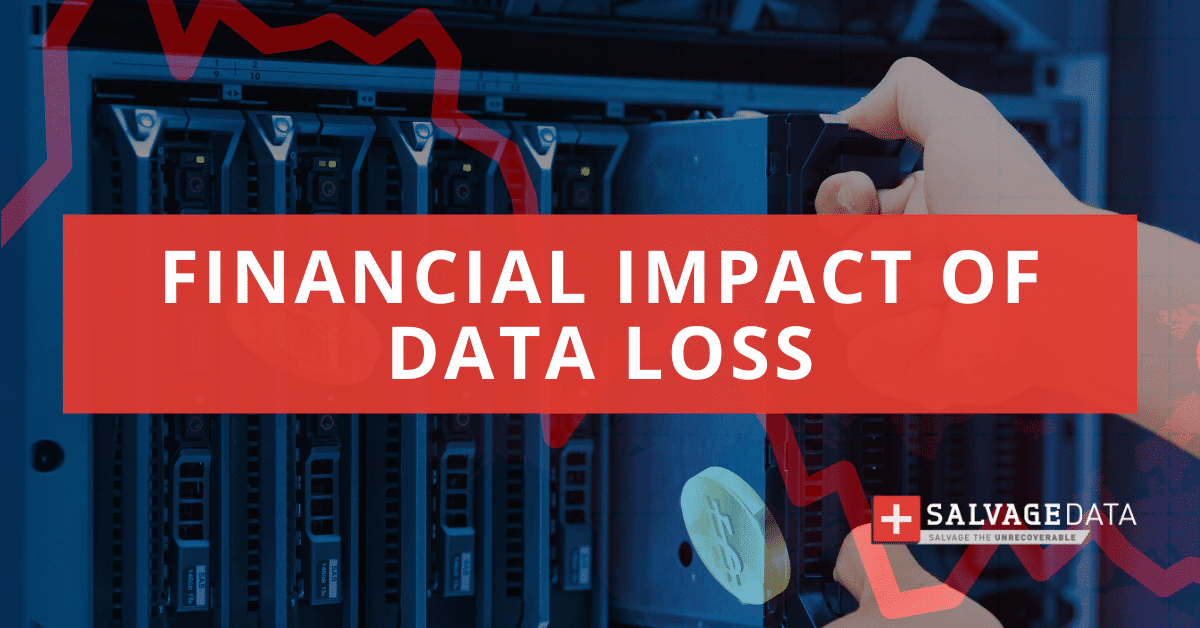
I think there's an issue with my storage device, but I'm not sure Start a free evaluation →
I need help getting my data back right now Call now (800) 972-3282
For businesses everywhere, data loss has a significant impact that goes beyond the loss of critical and sensitive data. It has a greater financial impact and the cost of data in 2023 in Canada so far is 4.45 million U.S. dollars, depending on the volume of data and the value of the lost data and its impact on operations.
Data loss means downtime, loss of client trust, loss of productivity and revenue, damage to brand reputation, failure to follow data privacy regulations, and broken business continuity. All these can lead to the closing of the business itself. For all this, data loss prevention (DLP) should be part of a business plan and culture from day one.
Financial loss due to data loss
As established by this article subject, one of the main impacts of data loss is the financial impact on businesses. The loss of critical data can cause significant disruptions to daily operations, impacting transactions with vendors, payroll, and other financial activities.
Recovering from data loss takes time and can cause IT disruptions right across an organization. This interference can seriously affect day-to-day business operations.
Data loss also exposes a business to various legal actions and lawsuits. Plus, the loss of customer data carries potential fines from the regulator for not adhering to data protection laws and regulations. Customers can also file lawsuits against a business in the event of loss of customer data.
Data loss causes financial impact also due to:
Downtime
Downtime can have a significant financial impact on businesses. The results of a global survey, which compiled the responses of 3,200 IT and decision-makers, suggest that data loss and downtime cost small businesses $427 cost-per-minute while for medium and large it is $9,000 cost-per-minute. The impact of downtime can be severe, leading to reduced productivity, lost revenue, and increased costs.
Broken trust, loss of reputation and customer loyalty
Data loss can result in reputational damages, leading to a loss in sales, customers, and future revenue. It is essential to communicate a data loss incident to customers, but it can inadvertently result in a lack of trust and discontentment.
Disruption and loss of productivity
Recovering from data loss takes time and can cause IT disruptions right across an organization. This interference can seriously affect day-to-day business operations. Production stoppages caused by data loss can also result in substantial financial consequences, like businesses experiencing losses of thousands in sales per minute. Even smaller data-loss events, such as the accidental deletion of a critical file, can lead to productivity losses as employees spend time locating or recreating the lost data.
Legal action
Data loss exposes a business to various legal actions and lawsuits. The loss of customer data carries potential fines from the regulator for not adhering to data protection laws and regulations. Customers can also file lawsuits against a business in the event of loss of customer data, increasing the cost of the data loss and the financial impact on the company.
Increases costs
Data loss can increase costs for businesses since recovering from data loss takes time and can cause IT disruptions right across an organization. This interference can seriously affect day-to-day business operations. Plus, if a data recovery service provider is required to retrieve the lost files and information, their cost must be added to the financial impact of data loss.
How to minimize damage during a data loss scenario
A key way for Canadian businesses to minimize damage to their business image and finances from potential data loss is to have recovery time and recovery point objectives (RTO and RPO) in place.
RTO refers to the time expected to restore operations after an outage, while RPO indicates how recent backup data should be. Establishing these metrics and regularly testing disaster recovery plans helps ensure systems and data can be restored quickly if lost.
Additionally, securing remote backups and replicating data across locations guards against site failures. With robust plans and infrastructure, businesses can better withstand inevitable data incidents.
How to prevent data loss
Data loss carries serious consequences for businesses of all sizes and in any industry. Therefore, looking for ways to prevent data loss can increase your revenue and ensure business continuity, as you’re keeping your clients and even having the opportunity to grow.
Businesses can implement the following tips and strategies to prevent data loss:
Develop a security policy for devices
Create a policy that outlines how employees should handle devices that contain sensitive data. This policy should include guidelines for password protection, encryption, and data backup.
Back up your data
Regularly back up your server data to prevent data loss. This can be done through cloud storage, external hard drives, or other backup solutions. It is essential to create a structured backup strategy and consistently back up your files. Your backup plan should include the different levels of data you maintain in your company and the schedule for their backups.
Use virus-detection protection programs
Use virus-detection protection programs and keep them updated to prevent malware and viruses from causing data loss or data breaches.
Make employees a part of your security plan
Train your employees on how to handle sensitive data and prevent data leakage. Keep your data security a high priority at all times.
Use data loss prevention (DLP) policies and tools
Implement DLP policies and tools, such as data encryption and multifactor authentication (MFA), to protect sensitive data, achieve in-depth data visibility, and secure your mobile workforce in BYOD environments.
Encrypting sensitive data can help prevent unauthorized access and data breaches. MFA can prevent unauthorized access to business accounts and files.
